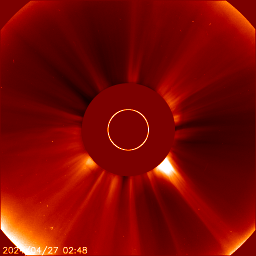sabato 26 maggio 2012
ASTEROIDE TROJAN ORBITA NELL'ORBITA DELLA TERRA
In a blow to school children and Disney fans everywhere, Pluto was demoted from a planet to a dwarf planet in 2006. The key argument against Pluto’s planet-hood was that other celestial bodies occupied its orbit, so Pluto was not the dominant gravitational object in that region.
The mere presence of other celestial bodies in Pluto’s orbit is only part of the story, though, because scientists have known for centuries that small objects called trojan asteroids can stably share an orbit with a larger celestial body. Astronomers have previously identified trojan asteroids in the orbits of Mars, Neptune, and Jupiter, but today astronomers from Athabasca University, UCLA, and University of Western Ontario are announcing the first direct observation of a trojan asteroid in Earth’s orbit.
Using Newton’s theory of gravitation, Joseph Louis Lagrange showed that there are five points, now known as Lagrangian points, in or near a planet’s orbit where a smaller object can orbit stably—the gravitational fields of the sun and the planet balance in these locations. The first two Lagrangian points (called L1 and L2) exist on either side of the planet on a line between the planet’s center and the center of the sun. L3 sits directly opposite the planet on the other side of the sun. L4 and L5 also sit in the planet's orbit, but in front of or behind it.
Each of these points are very important because they make excellent sites for space stations and observatories. For instance, the Solar and Heliocentric Observatory is located at Earth’s L1, and the James Webb Space Observatory is/was planned for L2. Langrangian points L3, L4, and L5 have been proposed as sites for future space stations and depots for the support of interplanetary missions. Similar Lagrangian points also exist in the orbit between the Earth and the Moon, and these could be exploited for lunar missions. There's a natural precedent for that, as small trojan moons have been identified in the orbits of some of Saturn’s moons.
Using Earth-based observations, it's easy to see whether objects occupy L1 or L2, because they are near Earth and sit either directly opposite the sun in the night sky or directly between the Earth and the Sun. We know that there are no trojan objects in these locations. From Earth, it's impossible to directly observe L3 because it is always on the opposite side of the sun from us. In principle, we should be able to observe objects at L4 and L5, but those observations are difficult because these points lie mostly in the daytime sky.
The authors of this study used archived data from the Wide-field Infrared Survey Explorer to identify possible trojan asteroids at Earth’s L4 point, and the data revealed two candidate objects that were several hundred meters in diameter. This data was then combined with direct observations of the objects made in April 2011 at the University of Hawaii, which refined knowledge of the objects’ orbit. With this data, the researchers were able to positively identify one of those objects, called 2010 TK7, as the first known trojan asteroid in Earth’s orbit.
2010 TK7’s orbit is not quite as stable as Lagrange originally predicted. Measurements show that it doesn't actually occupy the Lagrangian point itself, but oscillates around it. It also doesn't sit still in a single Lagrangian point, but shuttles between L3 and L4 with a period of about 400 years, and it is currently located near L4 at one of its closest approaches to Earth. If the current orbital pattern holds, over the next 200 years, 2010 TK7 will accelerate ahead of Earth until it reaches L3, slows, and eventually returns to L4 over the second 200 years of its 400 year cycle.
Due to the gravitational influence of other planets and the significant contribution of chaos to an asteroid’s orbit, it is impossible to accurately predict 2010 TK7’s behavior over more than a 250 year span, so it may not continue the cycle described above. One likely way it could change its cycle would be to break its pattern at L3 and begin to oscillate between L3 and L5 rather than L3 and L4. Thus, it is unclear whether 2010 TK7 will remain a trojan or whether other forces will eventually throw it out of its stable oscillations.
Iscriviti a:
Commenti sul post (Atom)






Nessun commento:
Posta un commento